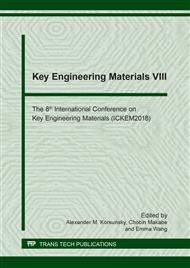[1]
S. Choi, M. S. Jang, J. H. Lee, J. H. Jeong and J. Kim, Supertough Hybrid Hydrogels Consisting of a Polymer Double‐Network and Mesoporous Silica Microrods for Mechanically Stimulated On‐Demand Drug Delivery, Advanced Functional Materials (2017).
DOI: 10.1002/adfm.201703826
Google Scholar
[2]
I. Liao, F. T. Moutos, B. T. Estes, X. Zhao and F. Guilak, Composite three‐dimensional woven scaffolds with interpenetrating network hydrogels to create functional synthetic articular cartilage, Advanced functional materials 23 (2013) 5833-5839.
DOI: 10.1002/adfm.201300483
Google Scholar
[3]
X. Zhang, C. L. Pint, M. H. Lee, B. E. Schubert, A. Jamshidi, K. Takei, H. Ko, A. Gillies, R. Bardhan and J. J. Urban, Optically-and thermally-responsive programmable materials based on carbon nanotube-hydrogel polymer composites, Nano letters 11 (2011).
DOI: 10.1021/nl201503e
Google Scholar
[4]
D. A. Sánchez-Téllez, L. Téllez-Jurado and L. M. Rodríguez-Lorenzo, Hydrogels for Cartilage Regeneration, from Polysaccharides to Hybrids, Polymers 9 (2017) 671.
DOI: 10.3390/polym9120671
Google Scholar
[5]
T. Huang, H. Xu, K. Jiao, L. Zhu, H. R. Brown and H. Wang, A novel hydrogel with high mechanical strength: a macromolecular microsphere composite hydrogel, Advanced Materials 19 (2007) 1622-1626.
DOI: 10.1002/adma.200602533
Google Scholar
[6]
Q. Wang, J. L. Mynar, M. Yoshida, E. Lee, M. Lee, K. Okuro, K. Kinbara and T. Aida, High-water-content mouldable hydrogels by mixing clay and a dendritic molecular binder, Nature 463 (2010) 339-343.
DOI: 10.1038/nature08693
Google Scholar
[7]
M. A. Haque, T. Kurokawa and J. P. Gong, Super tough double network hydrogels and their application as biomaterials, Polymer 53 (2012) 1805-1822.
DOI: 10.1016/j.polymer.2012.03.013
Google Scholar
[8]
J.-Y. Sun, X. Zhao, W. R. Illeperuma, O. Chaudhuri, K. H. Oh, D. J. Mooney, J. J. Vlassak and Z. Suo, Highly stretchable and tough hydrogels, Nature 489 (2012) 133-136.
DOI: 10.1038/nature11409
Google Scholar
[9]
S. Naficy, S. Kawakami, S. Sadegholvaad, M. Wakisaka and G. M. Spinks, Mechanical properties of interpenetrating polymer network hydrogels based on hybrid ionically and covalently crosslinked networks, Journal of Applied Polymer Science 130 (2013).
DOI: 10.1002/app.39417
Google Scholar
[10]
S. Yarimitsu, S. Sasaki, T. Murakami and A. Suzuki, Evaluation of lubrication properties of hydrogel artificial cartilage materials for joint prosthesis, Biosurface and Biotribology 2 (2016) 40-47.
DOI: 10.1016/j.bsbt.2016.02.005
Google Scholar
[11]
R. J. Covert, R. Ott and D. N. Ku, Friction characteristics of a potential articular cartilage biomaterial, Wear 255 (2003) 1064-1068.
DOI: 10.1016/s0043-1648(03)00113-3
Google Scholar
[12]
J. P. Gong, T. Kurokawa, T. Narita, G. Kagata, Y. Osada, G. Nishimura and M. Kinjo, Synthesis of hydrogels with extremely low surface friction, Journal of the American Chemical Society 123 (2001) 5582-5583.
DOI: 10.1021/ja003794q
Google Scholar
[13]
D. Baykal, J. Day, D. Jaekel, J. Katta, K. Mansmann and S. Kurtz, Tribological evaluation of hydrogel articulations for joint arthroplasty applications, Journal of the mechanical behavior of biomedical materials 14 (2012) 39-47.
DOI: 10.1016/j.jmbbm.2012.05.012
Google Scholar
[14]
J. K. Katta, M. Marcolongo, A. Lowman and K. A. Mansmann, Friction and wear behavior of poly (vinyl alcohol)/poly (vinyl pyrrolidone) hydrogels for articular cartilage replacement, Journal of Biomedical Materials Research Part A 83 (2007).
DOI: 10.1002/jbm.a.31238
Google Scholar
[15]
F. C. Linn, Lubrication of Animal Joints: I. THE ARTHROTRIPSOMETER, JBJS 49 (1967) 1079-1098.
Google Scholar
[16]
V. Bavaresco, C. Zavaglia, M. Reis and J. Gomes, Study on the tribological properties of pHEMA hydrogels for use in artificial articular cartilage, Wear 265 (2008) 269-277.
DOI: 10.1016/j.wear.2007.10.009
Google Scholar


